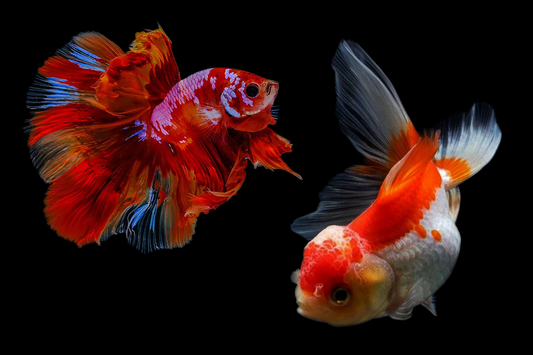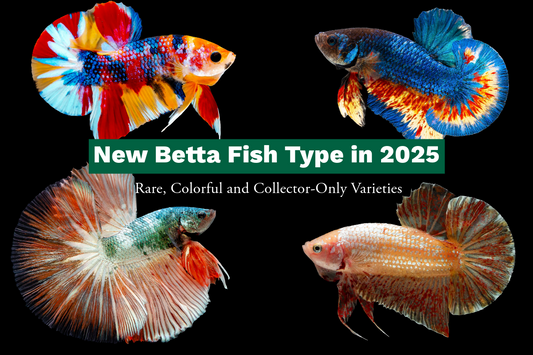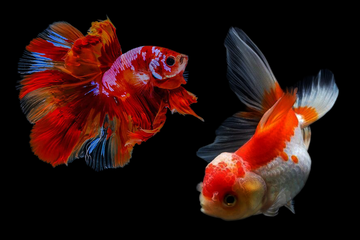Everything You Need to Know About Giant Betta Fish

Overview

Giant betta fish, renowned for their stunning looks and distinctive traits, have captured the hearts of fish enthusiasts worldwide. With their larger size and vibrant colors, they stand out among bettas and demand specialized care to flourish.
In this article, we delve into the fascinating world of giant betta fish, exploring their origins, habitats, care essentials, and breeding habits. Whether you're a seasoned betta aficionado or new to this captivating hobby, our comprehensive guide equips you with the knowledge to ensure the health of your giant betta companions.
What is giant betta fish?
Giant Betta fish are the product of selective breeding, aimed at developing a genetic trait for larger size. They possess a robust physique similar to Plakat Betta, but on a larger scale. While not widely sought after in the aquatics industry currently, their popularity is on the rise due to their tranquil temperament and impressive size.
Giant Betta Fish can reach lengths of approximately 7-10 inch and may even grow larger under ideal nurturing conditions. The remarkable aspect of the Giant Betta lies in the captivating beauty and unique individuality of each specimen. They can showcase a wide array of colors and patterns, ranging from vibrant and dazzling hues to distinctive color variations.
Origin and habitat
Origin
Giant Betta Fish are a unique breed of Betta fish resulting from meticulous selective breeding efforts. Originating primarily in Thailand, where Betta fish have a long-standing history of cultivation, they have also found their way into several Southeast Asian countries, including Malaysia, Indonesia, Vietnam, Laos, and Cambodia. These impressive fish trace their lineage back to the Plakat Betta, with notable distinctions in size and physique compared to other Betta fish varieties. They are primarily bred for display purposes or participation in ornamental fish competitions.
Habitat
Giant Betta Fish inhabit serene, freshwater environments such as rice paddies, stagnant ponds, marshes, and slow-flowing streams. Their natural habitat closely resembles that of other Betta fish species, typically thriving in freshwater with temperatures ranging from 24-30 degrees Celsius and a pH level of 6.5-7.5. They also exhibit a preference for resting in areas adorned with aquatic plants and shaded spots.
Giant betta fish appearance
Male and Female

Female Giant bettas are characterized by a more understated and muted coloration, while their male counterparts are known for their dazzling and vivid hues. These male bettas often display an array of captivating and vibrant colors, including shades of blue, green, red, and orange.
Despite the differences in coloration, both male and female gigantic bettas share the hallmark of betta fish – vibrant fins. These fins are a defining characteristic of betta fish and are present in both genders of gigantic bettas. When it comes to betta fish diversity, the gigantic betta variety is especially captivating due to its impressive size and striking appearance.
Size

In terms of size, male giant bettas can attain impressive lengths ranging from 3.5 to 4 inches. On the other hand, female giant bettas tend to be slightly smaller in size. However, when it comes to the enormous betta variety, they can reach even more impressive dimensions, growing to be between 5 to 7 inches in length.

What is difference between giant betta fish and regular betta fish
Giant bettas and regular bettas exhibit numerous distinctions in terms of size, appearance, temperament, and care requirements. Below are key points of differentiation:
-
Size: Giant bettas are considerably larger than their regular counterparts. Giant bettas can reach lengths of 3 to 7 inches, whereas regular bettas typically measure around 2 to 3 inches.
-
Appearance: Giant bettas have short and thick fins, resembling plakat bettas. Regular bettas possess long, slender fins with various styles such as the crowntail, halfmoon, and delta tail. Both types of bettas come in various colors, but giant bettas often display more vibrant hues.
-
Habitat: Giant bettas share the territorial and aggressive nature of regular bettas. However, due to their larger size, giant bettas can pose a threat to smaller or weaker fish. They also tend to be less patient and more intolerant of disruptions from other fish.
-
Care requirements: Giant bettas require larger aquariums than regular bettas. A single giant betta should have a minimum tank size of 10 gallons to ensure their comfort. Additionally, giant bettas need more food compared to regular bettas, as they grow quickly and expend more energy.
Breeding giant betta fish

Breeding giant betta fish is not an easy process. Thorough preparation is essential before you begin. Here are some fundamental steps for breeding giant betta fish:
-
Select the Pair: Choose a healthy male and female betta with good health, attractive colors, and appropriate size. Avoid close bloodlines to prevent genetic issues.
-
Prepare the tank: Set up a 20 gallon breeding tank with a temperature of 78-82°F (26-28°C) and a pH of 6.5-7.5. Include a heater, gentle filter, and hiding spots like plants. Leave space at the top for a bubble nest.
-
Introduce betta fish: Place the male in the tank first to establish territory with a bubble nest. Then introduce the female, keeping them separated with a barrier for a day or two.
-
Mating: When signs of readiness appear, remove the barrier for the pair to mate. The male will chase, nudge, and embrace the female to encourage egg production. After mating, he'll collect and place the eggs in the bubble nest.
-
Post-mating: Move the female to a separate tank. Leave the male to care for the nest and fry. Avoid disturbing the water, provide light feeding for the male, and prevent overfeeding.
-
Fry care: After a few days, the eggs hatch into fry. The male cares for them in the bubble nest. When they become free-swimming, transfer the male to a new tank. Feed the fry suitable food and perform daily water changes for optimal water quality. Please note that Giant Betta Fish take longer to grow than regular betta fish (up to 5 months to reach adult size).
Care guide for giant betta fish
Taking care of giant betta fish requires attention to detail and dedication. Here are some tips to help you care for your giant betta fish

Tank set up
Giant betta fish require a larger aquarium compared to regular bettas. A single giant betta needs a minimum of 10 gallons of water to thrive comfortably. The tank should be adorned with plenty of aquatic plants and rocks to create hiding spots and decoration for the fish. Maintain the water temperature in the tank between 76 to 82°F (24 to 28°C) and the pH level between 6.5 to 7.5. Regular water changes are necessary to maintain good water quality.
Filter
Giant bettas belong to the anabantoids family, which means they can obtain oxygen from the air through a specialized organ called the labyrinth. As a result, they don't require a powerful filter to maintain dissolved oxygen in the water. However, a filter is still essential to remove waste and reduce nitrate levels. Opt for a filter with gentle water flow to avoid stressing the fish. You can use options like hang-on filters, sponge filters, or aquatic plant-based filtration.
Heating
Giant bettas are tropical fish, so they need to be kept in warm water. If the tank temperature is too low or too high, they can become stressed or susceptible to diseases. Use a heater to maintain the tank temperature between 76 to 82°F (24 to 28°C). Additionally, use a thermometer to regularly monitor and adjust the heater as needed.
Food and diet

Giant bettas are omnivorous, meaning they can consume a variety of foods. However, they tend to lean towards animal-based foods, so provide them with high-protein options. You can feed them dry foods like pellets, flakes, or granules, but also include live or frozen foods such blood worms or artemia. Avoid overfeeding to prevent obesity or digestive issues. Supplement their diet with vitamins and minerals to enhance their immunity and appearance.
Where to Buy Giant Betta Fish
Tropicflow is your premier destination for all things betta fish, specializing in the rare and majestic giant betta fish. As an online betta fish store, Tropicflow offers a diverse selection of these captivating creatures, known for their striking colors and impressive size.
Conclusion
Giant betta fish are a unique freshwater species, distinguished by their larger size and robust vitality compared to their regular betta counterparts. With their vibrant colors and long fins, they create an impressive and captivating presence in any aquarium. To successfully raise giant betta fish, it's crucial to understand their origins, physical characteristics, distinctions, breeding methods, and proper care.
FAQ
What is the largest betta fish?
The largest betta fish can be the giant betta, which can reach up to 3 to 4 inches in body length, much larger than the typical betta splendens.
Are giant betta fish real?
Yes, giant betta fish are real. They are a selectively bred variation of the betta splendens species known for their larger size and striking appearance.
What is a king betta fish?
A king betta fish is essentially another name for a giant betta. They are often called "king bettas" due to their impressive size compared to regular bettas.
How big can my betta fish grow?
Betta fish typically grow to an average size of 2.5 to 3 inches in length, though giant bettas can grow larger, reaching up to 3 to 4 inches.
Can I breed giant betta with normal betta?
Breeding a giant betta with a regular betta is possible, but it may produce offspring of varying sizes. Some offspring may be giants, while others may be closer in size to regular bettas.
Are giant bettas less aggressive?
Giant bettas are not necessarily less aggressive than regular bettas. Their temperament can vary from individual to individual, with some being more aggressive and territorial, while others may be more docile. It's important to monitor their behavior and provide appropriate tank conditions to reduce aggression.
No comments











0 comments